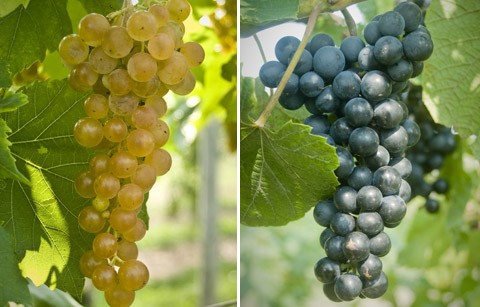Contest harvests names for new wine grapes
By Kate Frazer
After a naming challenge drew 1,100 suggestions from around the world, a Cornell breeder has revealed the secret identities of two new wine grapes: Arandell and Aromella.
Bruce Reisch, professor of horticulture in the College of Agriculture and Life Sciences, introduced the grapes at the wine industry conference Viticulture 2013 in Rochester, N.Y., Feb. 7.
Arandell – a mash-up of “arandano,” the Spanish word for blueberry, and the “ell” from Cornell – is the first grape released from the New York State Agricultural Experiment Station’s “no-spray” vineyard.
Reisch hopes its hint of blueberry will attract wine lovers, while its superior resistance to downy and powdery mildews will appeal to growers interested in sustainable practices. Its name was suggested by Michael Fleischhauer, a retired computer analyst and wine enthusiast from Juneau, Alaska.
Aromella, an aromatic, muscat white wine grape, was named by Michael Borboa, a California winemaker and songwriter. Aromella ranks high for winter hardiness and productivity. Reisch says its release is timely given the growing popularity of muscat wines.
The project emerged almost accidently when Anna Katharine Mansfield, assistant professor of enology, suggested emailing colleagues to introduce two varieties ripe for naming. As news of their appeal spread through the proverbial grapevine, it attracted coverage from outlets including NPR’s “Morning Edition” and Bon Appétit online.
“At one point messages were popping up in my inbox every 5 to 15 seconds,” Reisch said. “People proposed names but many also shared stories.”
Family tributes were a popular theme. One person suggested a grape be named for his wine-loving mother-in-law; another thought they should be named after his lively twin sons.
“One thoughtful person asked if I had a grape named for me, suggesting ‘Breischling,’” Reisch said.
But grape-naming is serious business. With 7,000-plus varieties on the market, new grapes face an uphill battle.
“You want something unique, but it has to be marketable, reasonably easy to pronounce and conjure positive connotations,” Reisch said. Names that sound foreign or similar to existing varieties are often popular, he added.
“The trickiest part is ensuring the name isn’t trademarked or already used in the industry,” said Mansfield. Once the list was pruned to 120, Reisch researched each name, then gathered opinions on 19 finalists from growers and winemakers.
They admit it was hard crossing off personal favorites. Many submissions had Cornell associations, like Big Red (Cornell’s mascot), A.D. White (Cornell’s first president) and Llenroc (Cornell spelled backwards). Others, like Genevieve, were inspired by the grapes’ birthplace in Geneva, N.Y.
Perhaps the most creative offering came from four different entrants, who suggested comedians Stephen Colbert and Jon Stewart be the namesakes.
“Colbert Red and Stewart White do have the essence of great grape names but are already associated with existing vineyards,” said Reisch.
He hopes winemakers will experiment with the grapes just as people did with their naming. Double A Vineyards in Fredonia, N.Y., and Grafted Grapevine Nursery in Clifton Springs, N.Y., have vines of Arandell and Aromella available for sale.
As for why the challenge caught on, Reisch thinks it has to do with immortality and the romance of wine: “After all, who wouldn’t want to name something people may enjoy for hundreds of years?”
Kate Frazer is the agricultural stations communications officer for the College of Agriculture and Life Sciences.
Media Contact
Get Cornell news delivered right to your inbox.
Subscribe